What’s been on the culinary reading stack recently?
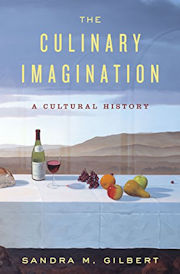 The Culinary Imagination: From Myth to Modernity by Sandra M. Gilbert (2014)
The Culinary Imagination: From Myth to Modernity by Sandra M. Gilbert (2014)
Started off with a bang, looking at the contemporary food scene, foodies, farm to table, and at the same time, the contrast of fast food and rising obesity rates. And then, unless you’re into the minutiae of literature, poetry, and art, it comes grinding to a halt. This is a sweeping work, covering various topics of food and how it relates to one or another creative cultural endeavor, and it gets very academic, very quickly.
It’s not that it’s not interesting for anyone who is passionate about the history of food and its relation to our lives, but it’s just really, really dry. There’s no question that the author intends it to be anything but, as she delves into different works of art or prose, but that what clearly fascinates her in an obsessive sort of way doesn’t come across quite as fascinating when on the receiving end.
I give it four stars mostly for the sweeping arc that it covers – there’s more information here than most of us want packed into our brains. And it goes on. And on. And on…..
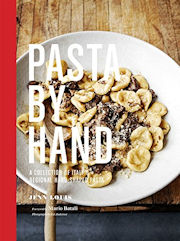 Pasta by Hand: A Collection of Italy’s Regional Hand-Shaped Pasta by Jenn Louis (2015)
Pasta by Hand: A Collection of Italy’s Regional Hand-Shaped Pasta by Jenn Louis (2015)
What an amazing collection of recipes, each presented with a bit of history and culture. Hand shaped pastas that you may never have heard of, I certainly found quite a few new ones for my repertoire.
I love the way it’s divided up into regions, and explores the different unusual (and some more well known) hand formed pastas, comparing and contrasting them. Too, I like that the author gives notes about both traditional sauces to accompany each, as well as alternates. The selection of sauces, recipes given at the end of the book, is somewhat limited and repetitive, and it might have been interesting if she’d given more generic thoughts about what sort of sauces one might consider – at the same time, anyone delving into a book this intricate is likely to be able to look at the suggestions and come up with their own alternatives with minimal effort.
Now to start in on actually trying them!
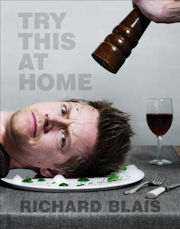 Try This at Home: Recipes from My Head to Your Plate by Richard Blais (2013)
Try This at Home: Recipes from My Head to Your Plate by Richard Blais (2013)
Blais was one of my favorite contestants over the various years of Top Chef, and I really like his approach to combining elements of modernist cooking with classic flavors and dishes. At times, yeah, he goes over the top and deconstructs or reconstructs or reimagines in a way that doesn’t strike me as appetizing, but for the most part, he restrains those wilder impulses. And in the book, he really pulls back, and makes his ideas completely accessible for the home cook. In particular I like that when he has a very modernist, i.e., molecular gastronomy, type of method or component of a dish, he not only talks you through it, but then offers up an alternative way to make the dish that doesn’t involve anything other than the usual pots and pans and kitchen equipment that almost anyone who cooks has at home.
He can be a little long-winded, and there were moments when I found myself skimming over things just to get to his point. But that seems to be his personality, and so it feels very much like you’re sitting there listening to him talk directly to you the way he would anyway. Overall, a really great read!
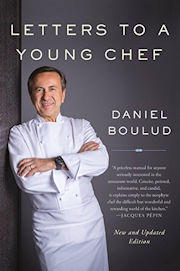 Letters to a Young Chef by Daniel Boulud (2006)
Letters to a Young Chef by Daniel Boulud (2006)
I gather this is part of a series of “mentoring” books in various professions, written by well known professionals as advice to aspirants. Given the task, I suppose it works, but I found it to be a bit rambling, and a bit dull. Somehow Boulud manages to make the passion and creativity of the world of becoming a chef sound as interesting as an entry level job washing dishes or peeling potatoes. I don’t know if the intent of these mentoring books is to discourage someone from entering into their potential career, but if so, this series of dry essays, which is really what they are, rather than what I think are intended to be imagined letters to a younger self or colleague, certainly could accomplish that. Overall, kind of disappointing – I understand wanting to spell out the hard work it takes to become an accomplished chef, and the pitfalls along the way, but it might have been nice to make the rewards of the hard work sound like something more than just more hard work.
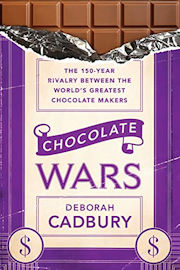 Chocolate Wars: The 150-Year Rivalry Between the World’s Greatest Chocolate Makers by Deborah Cadbury (2010)
Chocolate Wars: The 150-Year Rivalry Between the World’s Greatest Chocolate Makers by Deborah Cadbury (2010)
A fascinating look back at the history not only of the development of chocolate as a worldwide commodity and treat, but at the individuals who made it happen. Cadbury (yes, of the chocolate-making family) delves into the personalities, the times and culture in which they lived – there’s a focus on British chocolate makers at its core, but she doesn’t skimp on American and Swiss entrepreneurs either. We see everything from how their religious and work ethics helped shape the businesses we know today, to their personal foibles and familial problems. Although not the primary scope of the book, she also looks at the cocoa trade and how different chocolate manufacturers dealt with problems of everything from growing cocoa to slave labor. It’s a long book, but well worth a read!